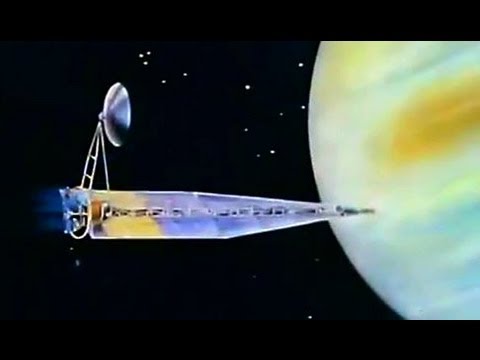more at
“This video presents an overview of low thrust rocket engine propulsion concepts for space missions. Chemical and electrical rocket engines are shown. Animation illustrates various propulsion applications.”
Public domain film from NASA, slightly cropped to remove uneven edges, with the aspect ratio corrected, and mild video noise reduction applied.
The soundtrack was also processed with volume normalization, noise reduction, clipping reduction, and/or equalization.
An ion thruster is a form of electric propulsion used for spacecraft propulsion that creates thrust by accelerating ions. The term is strictly used to refer to gridded ion thrusters, but may often more loosely be applied to all electric propulsion systems that accelerate plasma, since plasma consists of ions. Ion thrusters are categorized by how they accelerate the ions, using either electrostatic or electromagnetic force. Electrostatic ion thrusters use the Coulomb force and accelerate the ions in the direction of the electric field. Electromagnetic ion thrusters use the Lorentz force to accelerate the ions.
Ion thrusters create very small levels of thrust compared to conventional chemical rockets but achieve very high specific impulse, or propellant mass efficiencies, by accelerating their exhausts to very high speed. However, ion thrusters carry a fundamental price: the power imparted to the exhaust increases with the square of its velocity while the thrust increases only linearly. Normal chemical rockets, on the other hand, can provide very high thrust but are limited in total impulse by the small amount of energy that can be stored chemically in the propellants. Given the practical weight of suitable power sources, the accelerations given by ion thrusters are frequently less than one thousandth of standard gravity. However, since they operate essentially as electric (or electrostatic) motors, a greater fraction of the input power is converted into kinetic exhaust power than in a chemical rocket…
The Magnetoplasmadynamic (MPD) thruster (MPDT) is a form of electrically powered spacecraft propulsion which uses the Lorentz force (the force on a charged particle by an electromagnetic field) to generate thrust. It is sometimes referred to as Lorentz Force Accelerator (LFA) or (mostly in Japan) MPD arcjet.
Generally, a gaseous fuel is ionized and fed into an acceleration chamber, where the magnetic and electrical fields are created using a power source. The particles are then propelled by the Lorentz force resulting from the interaction between the current flowing through the plasma and the magnetic field (which is either externally applied, or induced by the current) out through the exhaust chamber. Unlike chemical propulsion, there is no combustion of fuel. As with other electric propulsion variations, both specific impulse and thrust increase with power input, while thrust per watt drops.
There are two main types of MPD thrusters, applied-field and self-field. Applied-field thrusters have magnetic rings surrounding the exhaust chamber to produce the magnetic field, while self-field thrusters have a cathode extending through the middle of the chamber. Applied fields are necessary at lower power levels, where self-field configurations are too weak. Various propellants such as xenon, neon, argon, hydrogen, hydrazine, and lithium have been used, with lithium generally being the best performer…
Arcjets are a form of electric propulsion for spacecraft, whereby an electrical discharge (arc) is created in a flow of propellant (typically hydrazine or ammonia). This imparts additional energy to the propellant, so that one can extract more work out of each kilogram of propellant, at the expense of increased power consumption and (usually) higher cost. Also, the thrust levels available from typically used arcjet engines are very low compared with chemical engines.
When the energy is available, arcjets are well suited to station keeping in orbit and can replace monopropellant rockets…
A resistojet is a method of Spacecraft propulsion (Electric propulsion ) that provides thrust by heating a (typically non-reactive) fluid. Heating is usually achieved by sending electricity through a resistor consisting of a hot incandescent filament, with the expanded gas expelled through a conventional nozzle.
Resistojets have been flown in space since 1965 on board of Air Force Vela satellites, however they became used in commercial applications in 1980 with launch of first satellites in the INTELSAT-V program. Nowadays resistojet propulsion is used for orbit insertion, attitude control, and deorbit of LEO satellites, including satellites in the Iridium satellite constellation…

